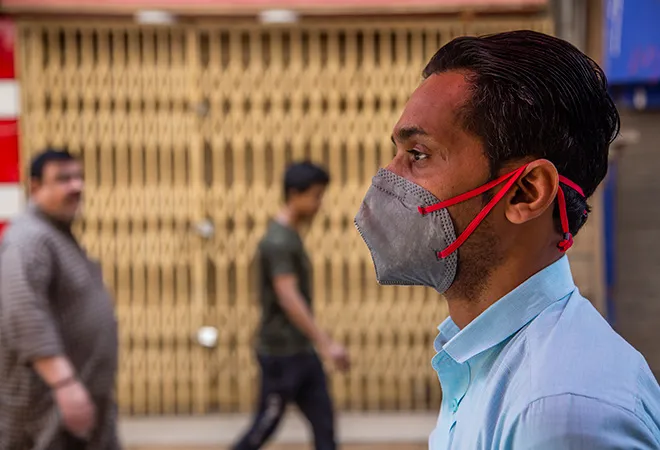-
CENTRES
Progammes & Centres
Location
How is Maharashtra faring as compared to other states — and what is the status of the spread of COVID-19 within the state?

With global numbers of COVID-19 cases unabashedly rising, India has made its share of contribution, reporting 0.77 percent (17,545) of the global coronavirus cases (2,241,359). Within India, Maharashtra leads with the number of cases at 4,200, followed by Delhi at 2,003 and Gujarat at 1,857. How is Maharashtra faring as compared to other states, and what is the status of the spread of the virus within the state?
Maharashtra, as of 20 April, has 4,204 cases, which makes up 23.94 percent of the total cases of 17,545 in India. In terms of deaths, Maharashtra is at 223 which accounts for 41 percent of India’s total 553 deaths.
| INDIA | MAHARASHTRA | Maharashtra as a % of India | |
| TOTAL CASES | 17,545 | 4,200 | 23.94 |
| NEW CASES | 1,554 | 553 | 35.59 |
| TOTAL DEATHS | 567 | 223 | 41 |
| NEW DEATHS | 36 | 12 | 33.33 |
| MORTALITY | 3.14% | 5.3 % |
It is difficult to compare states based on the mortality rates; though Meghalaya technically has the highest mortality at 9.09 percent, only because the ratio of 1 death for 11 total cases skews the mortality figure to the higher side. Similarly, with Punjab, which has 244 cases and 16 deaths. However, when comparing mortality rates, it is found that states on the higher end of the spectrum in terms of cases are not reflected in mortality rates. While Maharashtra leads the country in mortality rates at 5.3 percent with 4,200 cases, Delhi and Gujarat account for 2.25 and 3.61 percent, while Madhya Pradesh is at 5.12 percent with 1,407 cases.
Highest Cases State Level Comparison of Mortality Rates
| STATE | NO. OF CASES | NO. OF DEATHS | MORTALITY (%) |
| MAHARASHTRA | 4,200 | 223 | 5.31 |
| DELHI | 2,003 | 45 | 2.25 |
| GUJARAT | 1,857 | 67 | 3.61 |
| MADHYA PRADESH | 1,407 | 72 | 5.12 |
| TAMIL NADU | 1,477 | 15 | 1.02 |
| RAJASTHAN | 1,495 | 24 | 1.61 |
The Government of Maharashtra’s Department of Medical Education and Drugs and Public Health Department released a consolidated report of COVID-19 cases on 20 April, which captures latest figures in comparison to the global situation and national figures. It also revealed important disaggregated data on the age and gender of infected people, which is useful in determining the reach of this virus in different districts.
The date and day wise trends of COVID-19 cases in India and Maharashtra in the report show a sharper rise in national figures as the days progressed, and a gentler slope for numbers in Maharashtra, which may be an indication of steady testing and numbers being revealed periodically. In terms of the day wise distribution of COVID-19 numbers in Maharashtra, the figures reveal that there is no steady peak or rise — for example, the 38th day reported 350, which fell to 226 on Day 39, rose to 288 on Day 40, and fell to 119 on Day 41.
Due to the outbreak of the virus in dense slum areas of Dharavi and Koliwada, Mumbai has the record number of cases in Maharashtra as well as the country, with 2,724 cases. With numerous areas declared containment zones or sealed off, the state has initiated aggressive testing in order to mitigate the spread. Mumbai is followed by Pune at 611 and Thane at 348 cases. Mumbai also has the highest number of recoveries at 304 followed by Pune at 102. Sangli comes in third with 25 recoveries from the 27 cases it has reported, showing a recovery rate of 92.3 percent.
The age wise distribution of COVID-19 cases in Maharashtra shows that people aged 21-40 years have the most number of cases at 1,542. Maharashtra has effectively debunked the theory that only the old are vulnerable to being infected, as the number of cases among those aged 61-110 years is much lower at 469. This could also be a result of a larger younger demographic in the state, as well as the country. However, these figures do point out in stark detail the requirement of everyone, young or old, to treat the virus and government lockdowns with the seriousness that the situation warrants. The age group 61-80 years has the highest mortality rate of 18.6 percent. While the mortality of older people is clearly higher, with rates increasing steadily as age groups increase, younger carriers exposing themselves pose the larger risk.
| Sr. No. | Age group (years) | No. of Patients | No. of Deaths | Mortality % |
| 1. | 0-20 | 449 | 0 | 0.00 |
| 2. | 21-40 | 1,542 | 20 | 1.3 |
| 3. | 41-60 | 1,188 | 103 | 8.67 |
| 4. | 61-80 | 430 | 80 | 18.6 |
| 5. | 81-110 | 39 | 5 | 12.82 |
| TOTAL | 3,648 | 208 | 5.70 |
Furthermore, since 62 percent of the total number of tests conducted in Maharashtra (71,321) have been asymptomatic, the chances of asymptomatic carriers infecting the vulnerable has been quantified and proven in Maharashtra. Currently the status of admitted patients undergoing COVID-19 treatment shows 81 percent being in critical condition, 17 percent symptomatic patients and two percent asymptomatic patients. This shows that hospitals are recommending asymptomatic patients and patients with mild symptoms to self-quarantine at home, in order to relieve hospital resources for critical patients.
The report has also released gender-segregated data, where it is revealed that 60 percent of the total cases, or 2,177 cases, are males and 40 percent, 1,471 cases, are females. The respective deaths are at 64 percent for males and 36 percent for females. These are important indicators that reflect the trends of a larger proportion of women partaking in home-based work and self-employment, which prevents them from venturing out, and automatically results in social distancing.
In times of novel crises, data is of utmost importance in determining how governments and medical professionals can buttress health infrastructure and contain the spread. Maharashtra’s revelation of case numbers, testing numbers, and age and gender disaggregated data will prove fruitful in assessing how the state can redouble and refocus its efforts in containing the virus. These figures should result in making guidelines to help the health infrastructure cope with rising numbers by admitting only critical patients and creating isolation guidelines for milder patients at home. A larger effort to spread awareness about the lack of age-discrimination in getting infected must be made, using this data. Widespread testing remains the key — Maharashtra must continue this effort in order to continue its cluster containment strategies, curate aggressive quarantine measures for potential patients, and ensure citizens strictly adhere to lockdown guidelines. Testing may reveal that the situation is getting worse — but it is a priority in order for everything to get better.
The views expressed above belong to the author(s). ORF research and analyses now available on Telegram! Click here to access our curated content — blogs, longforms and interviews.

Aditi Ratho was an Associate Fellow at ORFs Mumbai centre. She worked on the broad themes like inclusive development gender issues and urbanisation. ...
Read More +